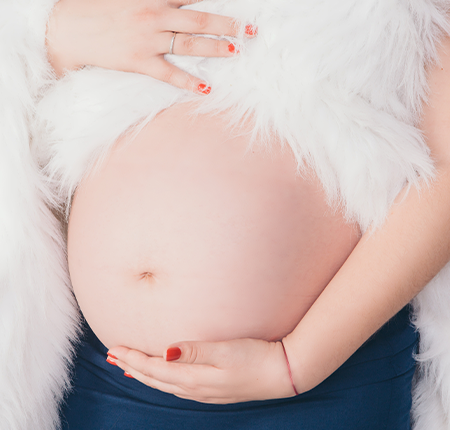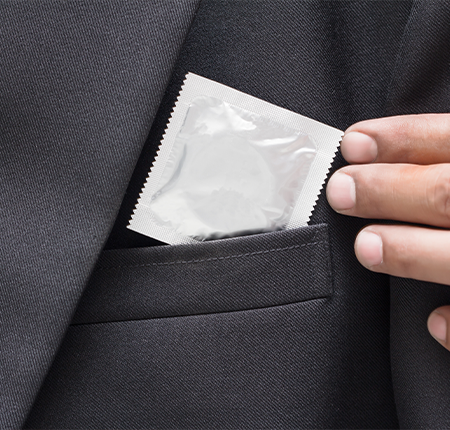
Pre-ejaculatory fluid is not the same as seminal fluid. And yet, how is it possible to get pregnant if there has been no ejaculation?
We know that there are questions that give you headaches, especially if you rely on the withdrawal method or if you and your partner only use the condom later during intercourse. Let's clarify all these aspects, so that there are no more doubts. Find out what pre-ejaculatory fluid is, what risks it poses and whether you can get pregnant from it.
What is preejaculatory fluid?
Pre-ejaculatory fluid, also known as pre-seminal fluid, as well as Cowper's fluid is, as you can probably tell from the name, a type of fluid that is removed from the penis before the partner ejaculates. It is a thick, clear, natural lubricant that is similar to, but not the same as, semen.
One of the key differences is where the two fluids are produced:
Seminal fluid (or sperm) is produced in the testicles.
Preseminal fluid is produced in the bulbourethral sex glands. These glands are also called Cowper's glands, hence the name Cowper's fluid. The glands of Littre and Morgagni also contribute to the production of fluid.
Another difference is the amount of sperm contained.
The seminal fluid released during ejaculation contains sperm to create a pregnancy.
Pre-ejaculatory fluid does not theoretically contain sperm.
However, sometimes sperm may already be present in the urethra and mix with the pre-seminal fluid before it is expelled. Because of this, it too can contain small amounts of sperm that can lead to pregnancy.

The role of preejaculatory fluid
If its primary purpose is not to transport sperm (because that is the role of sperm), then why does preejaculatory fluid exist and what functions does it perform? Well, it has two main roles:
Reduces friction and irritation during intercourse, acting as a natural lubricant.
Protects sperm and supports sperm health.
In terms of its role as a lubricant, pre-ejaculatory fluid is similar to the fluid your vagina produces when you're aroused. Its glycoprotein content provides lubrication during intercourse. Its role is to facilitate penetration, make it more pleasant and prevent irritation.
As for its protective role, it contains nutrients (protein, calcium, potassium, sodium and zinc) and other substances that keep the seminal fluid healthy (water, fructose, etc.). Sperm and urine are passed through the same tube, and the more acidic pH of urine can kill sperm. But since the pre-ejaculatory fluid is more alkaline, it can neutralize the acidity in the urethra so that the sperm can survive and be transported safely.
When is preejaculatory fluid removed?
Pre-ejaculatory fluid is released involuntarily when a man is aroused. It can be eliminated during masturbation or during sexual intercourse, but always before the moment of ejaculation.
It is very important to know that the elimination of this fluid cannot be controlled. Some men feel and can control the moment of orgasm (and ejaculation), but this is impossible for pre-ejaculatory fluid.
Can you get pregnant from pre-ejaculate?
Because the release of pre-ejaculatory fluid is involuntary and because it may contain sperm, there is a risk that it will reach the vagina and cause a pregnancy even if the partner does not ejaculate.
That's why couples who use the withdrawal method, which I told you all about HERE , are not protected from an unwanted pregnancy. The chances of pregnancy are indeed lower due to the fact that the pre-ejaculatory fluid contains a much smaller amount of sperm. But according to statistics, about 27% of sexual contacts protected only by the withdrawal method, without other contraceptive methods, resulted in a pregnancy.

The risk of pregnancy outside the ovulation period
Of course, the risk of getting pregnant from pre-ejaculatory fluid is also influenced by other factors, such as when you ovulate. For example, the chances of the egg being fertilized by a sperm are much higher if you have sex during your fertile period than outside of ovulation.
However, the withdrawal method combined with planning intercourse outside the ovulation period is not an effective contraceptive method. Sperm can survive in the female reproductive tract for up to 5 days, so fertilization can occur even when you don't have sex at ovulation, but 5 days before.
Furthermore, it is very difficult to calculate your fertile period if you have irregular periods, so there is a real risk of pregnancy even when you think you are not ovulating.
Can diseases be transmitted through pre-ejaculatory fluid?
Yes! Pre-ejaculatory fluid can carry numerous bacteria, viruses and microorganisms from your partner's body into your vagina during intercourse.
So if your partner is infected with, for example, HIV, Chlamydia, gonorrhea, hepatitis B or other bacteria and viruses, even without symptoms, he can transmit them to you during sexual contact. You can read HERE everything you should know about sexually transmitted diseases and how to protect yourself.
But in short, always use a condom right from the beginning of sexual intercourse, so as not to let the pre-ejaculatory fluid reach the vagina. This way you will be protected not only against an unwanted pregnancy, but also against sexually transmitted infections.
Can pre-ejaculation be avoided/prevented?
No, just as natural vaginal lubrication cannot be controlled or stopped. The release of preseminal fluid is not voluntary and often not even conscious. So even a partner who can control his orgasm and the timing of his ejaculation will not be able to avoid or control his pre-ejaculation.
The only way to prevent a pre-ejaculatory pregnancy with certainty is if your partner has a vasectomy. In this case, neither the pre-seminal fluid nor the seminal fluid will contain spermatozoa after a few months when they will be completely eliminated from the partner's body.
But even after vasectomy, the pre-seminal fluid will be removed and will cause lubrication, which cannot be controlled.

Safe contraceptive methods
In order for the condom to really protect you from an unwanted pregnancy, it must be worn from the beginning of sexual intercourse, so that the pre-ejaculatory fluid does not reach the vagina.
So if you want unprotected sex, there are other safe contraceptive methods that can prevent pregnancy even if pre-ejaculation occurs. Some of these are:
- The IUD: protects you from pregnancy if inserted even 5 days after unprotected sex. It is a long-term method of contraception that on average only needs to be replaced once every 7-10 years and does not affect fertility after removal. I told you more about how it is mounted, how many types it is and how to extract the sterile device HERE .
- Contraceptive pills: one of the most used methods of contraception is contraceptives . These prevent ovulation and the release of the egg, so even if sperm do reach the female reproductive tract, they will not have an egg to fertilize to produce a pregnancy.
- The morning-after pill: If you still had unprotected sex, there is plan B. The morning-after pill is an emergency contraceptive method that is taken as soon as possible, within 5 days of unprotected sex. This delays ovulation and thickens the cervical mucus to prevent the release of the egg and block the access of the sperm.
It is good to know that all these methods only prevent pregnancy, not infection with a sexually transmitted disease. So use them along with a condom or other barrier method if you have a new partner, if you have multiple partners, or if there is any possibility that your partner may be infected, so that you are fully protected.






















